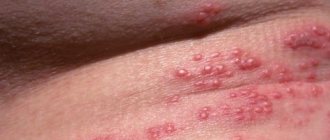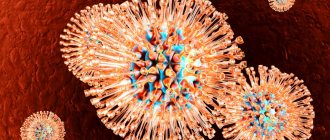How can you get infected with herpes
The content of the article
The disease is caused by the herpes simplex virus (HSV, Herpes simplex virus). Of the eight types of this pathogen, genital lesions are the result of two infectious agents. HSV-2 causes 80% of cases of the disease, and HSV-1 - 20%. There are also combined infections, in which both viral types are to blame.
There is a misconception that herpes on the lips and genitals are completely different diseases. In fact, both types of pathogens often “swap places” during domestic infection and oral sex. And both infections are equally dangerous.
Both types of virus are transmitted:
- For all types of sexual contact - vaginal, oral, anal, during which the virus enters the body through microdamage to the mucous membrane. You can also become infected from a partner who does not have rashes on the genitals or other manifestations of the disease. This condition is possible with strong immunity, when the virus lies low and waits in the wings. A person becomes a carrier of a herpes infection, but does not experience any health problems.
- Through common objects - washcloths, sponges, bed linen, towels. A person with a cold sore caused by the type 1 virus can become a source of genital herpes infection.
- During autoinoculation (self-infection), when the patient transfers the pathogen from the face to the genitals.
- A child becomes infected from a sick mother when the virus penetrates from the vagina into the uterus or transplacentally through the placenta. During childbirth, infection occurs as the newborn passes through the birth canal.
Statistics of hidden and overt forms of herpes
The body cannot overcome the pathogen on its own. The virus settles in the roots of the spinal cord, and the infected person continues to live with the disease throughout his life.
The pathogen can remain in the body for many years without causing symptoms. Therefore, it is impossible to know without testing for herpes whether a person is infected with the virus. According to WHO, type 1 herpes, which causes a rash on the lips and genitals, affects 67% of the world's inhabitants, and type 2 affects 11% of people. Only 20% of the disease occurs in the classical form, which is beyond doubt. In the rest, the course of the disease is latent or asymptomatic.
Sources
- Bougioukas L., Psoinos RBC., Jones DC., Morris EA., Hale AJ. Disseminated herpes simplex virus 2 as a complication of pregnancy. // IDCases - 2022 - Vol24 - NNULL - p.e01107; PMID:33889496
- Hammad W.A.B., Konje J.C. Herpes simplex virus infection in pregnancy - An update. // Eur J Obstet Gynecol Reprod Biol - 2022 - Vol259 - NNULL - p.38-45; PMID:33581405
- Elsaie ML., Youssef EA., Nada HA. Herpes zoster may be a marker for COVID-19 infection during pregnancy. // Cutis - 2022 - Vol106 - N6 - p.318-320; PMID:33471879
- Chatroux IC., Hersh AR., Caughey AB. Herpes Simplex Virus Serotyping in Pregnant Women With a History of Genital Herpes and an Outbreak in the Third Trimester of Pregnancy: A Cost-Effectiveness Analysis. // Obstet Gynecol - 2022 - Vol137 - N1 - p.63-71; PMID:33278294
- Leruez-Ville M., Driessen M., Pichon C., Sellier Y., Charlier C. . // Virologie (Montrouge) - 2022 - Vol24 - N5 - p.315-324; PMID:33111705
- Urato AC. ACOG Practice Bulletin No. 220: Management of Genital Herpes in Pregnancy. // Obstet Gynecol - 2022 - Vol136 - N4 - p.850-851; PMID:32976371
- Kim JY., Ko YR., Sim SE., Oh S., Lee MH., Park HJ. Safe drug treatment and procedure for herpes zoster in pregnancy: a case report. // Chin Med J (Engl) - 2022 - Vol133 - N16 - p.1999-2000; PMID:32826470
- Farsimadan M., Motamedifar M. The effects of human immunodeficiency virus, human papillomavirus, herpes simplex virus-1 and -2, human herpesvirus-6 and -8, cytomegalovirus, and hepatitis B and C virus on female fertility and pregnancy. // Br J Biomed Sci - 2022 - Vol78 - N1 - p.1-11; PMID:32726192
- Carbillon L., Bernuau J. Acute Herpes Simplex Virus Hepatitis in Pregnancy. // Obstet Gynecol - 2022 - Vol136 - N1 - p.193-194; PMID:32590706
- No authors found Acute Herpes Simplex Virus Hepatitis in Pregnancy: Correction. // Obstet Gynecol - 2022 - Vol135 - N6 - p.1489; PMID:32443075
Primary herpes
There are three periods of illness:
- Prodromal
(precursor period), during which the temperature rises, the inguinal lymph nodes become inflamed, weakness, fatigue, and headache appear. A person experiences a condition similar to the symptoms of flu and colds. If you take an antiviral drug during this period, the disease may not develop. If the symptoms are ignored and treatment is not started on time, the second period of the disease begins. - A rash
that occurs three to four days after the onset of a flu-like condition. Common symptoms include pain, heat, swelling, itching in the genital area, anus, buttocks, pubis and perineum. Soon, numerous blisters filled with clear liquid appear on the inflamed skin and mucous membranes, reminiscent of a “cold” on the lips. The rash causes pain and itching, worse at night and leading to insomnia. - Ulcerations.
After some time, the blisters burst and ulcers (erosions) form in their place, surrounded by a focus of inflammation. Contact with stool and urine on the eroded surface increases pain and complicates tissue regeneration. - Healing,
during which the ulcers gradually heal. If the genital organs are poorly cleaned, the immune system is weak, and infection occurs, the healing process is delayed.
After the ulcers disappear, the disease goes into remission. During this period, despite the presence of the virus in the body, there are no rashes on the genitals.
Lactation
Postpartum women with active disease can breastfeed as long as herpes lesions do not appear on the breasts. However, special care should be taken to wash your hands thoroughly, as infections acquired by a newborn after childbirth can be very severe.
Hand hygiene
The use of precautionary measures also applies to other family members who come into contact with the child. It should be remembered that lesions of the skin or mucous membrane, in addition to the genital area, are potential sources of infection. The use of acyclovir during lactation is safe for a well-fed baby.
Recurrent herpes
In 50%-70% of people the disease becomes chronic. This is facilitated by:
- untimely or incorrect treatment;
- decreased immunity, including that caused by taking medications that suppress the immune system;
- presence of other STDs;
- strict diets, vitamin deficiencies;
- state of chronic stress.
Why do patients develop relapses, during which the disease affects the same parts of the body? There are several reasons for this:
- Having penetrated the body, the virus settles in the tissues of the genital organs. As it multiplies, it affects cells deeper and deeper until it reaches nerve cells - neurons connected to each other by processes - axons. Through them, like bridges, the pathogen reaches the cells of the spinal cord, into which it introduces its DNA.
- An infected brain cell becomes an “incubator” for viruses, which periodically return via axon bridges to the mucous membrane or skin, causing new rashes. Schematically, the process is similar to the migration of birds, constantly returning to their “native places.”
- The immune system cannot kill viruses hidden in the spinal cord, but it deals with those that have left the “shelter”. Therefore, with high immunity, relapses occur rarely or not at all. But as soon as the body “loses its vigilance” - weakens, gets sick, catches a cold, is exposed to stress - the pathogens begin to overcome the immune defense. As a result, they reach their target - the skin and mucous membranes of the genital organs. Here, the increased reproduction of viral particles inside the “captured” cells begins. Cellular structures, dying, release myriads of viruses that cause inflammation, redness, swelling and the appearance of blisters. Herpes is causing another aggravation.
- Gradually, the immune system fights back the virus, and within 10 days the ulcers at the site of the rash dry out and heal. Everything returns to normal, so that at the slightest weakening of the immune system it can start again.
From the mechanism of exacerbations, it becomes clear why herpetic eruptions appear in the same places. It’s just that the virus cells return back only through the nerve cell from which they penetrated deep into the body.
Types of recurrent herpes
Depending on the number of exacerbations, several types of the disease are distinguished:
- mild, occurring up to 3 times a year;
- moderate severity, in which exacerbations occur 4-6 times a year;
- severe, accompanied by frequent exacerbations, intervals between which do not exceed a month;
- arrhythmic, in which after a period of imaginary well-being, lasting from a month to five, rashes appear. This form of herpes is characterized by a pattern - the longer the remission, the more severe the disease;
- menstrual, manifested by rashes during menstrual periods. This type of disease is severe and difficult to treat;
- subsiding, in which the manifestations of the disease constantly become weaker, and the inter-relapse periods become longer. The subsidence of the manifestations of the disease indicates the positive dynamics of treatment and the restoration of immune defense that suppresses the virus.
Microtrauma of the vaginal mucosa, video
is not responsible for the accuracy of the information presented in this video clip.
Source - KVD - dermatovenerological dispensary Sources:
- GENITAL INJURIES. Merritt Diane F. // Reproductive health of children and adolescents. – 2016. – No. 1. – P. 64-80.
- DRUGS FOR VAGINAL USE FOR PREVENTION AND TREATMENT OF DISORDERS OF THE FEMALE UROGENITAL ECOSYSTEM. Ayupova G.V., Fedotova A.A., Bondarenko K.R., Mavzyutov A.R., Ishemgulov A.M., Shikova Yu.V., Batyrova E.D., Petrova V.V. // News of the Samara Scientific Center of the Russian Academy of Sciences. – 2012. – No. 5 (2). – pp. 315-319.
- MANAGEMENT OF THE POSTPARTUM PERIOD IN PURTHER WOMEN WITH SOFT TISSUE INJURIES OF THE BIRTH CHANNEL. SELIKHOVA M.S., BELAN E.B., KOTOVSKAYA M.V., EFREMOVA E.B. // MEDICINE BULLETIN, Volgograd Medical Chamber. – 2012. – Volume 6, issue 8 (48). – P.7-10.
- Microbiocenosis of the vagina of modern practically healthy women of young reproductive age. V.S. Orlova, Yu.I. Naberezhnev, I.V. Budnik // Scientific bulletins. - 2008. - No. 6 (46). — P. 27-35.
- Complex therapy of bacterial vaginosis. F.F. Badretdinova, M.A. Akhmetgalieva, M.A. Nurtdinov // Medical Bulletin of Bashkortostan. - 2008. - T. 3, No. 2. P. 28-31.
- Bacterial vaginosis: clinical features, diagnosis and treatment. A.S. Ankirskaya, V.N. Prilepskaya, G.R. Bayramova and others // Russian Medical Journal. 1998. - No. 6 (5). — pp. 276-282.
- https://www.verywellhealth.com/vaginal-dryness-causes-and-treatments-3522435
- https://www.uptodate.com/contents/vaginal-dryness-beyond-the-basics?source=see_link
- https://medlineplus.gov/ency/article/000892.htm
- https://www.omicsonline.org/open-access/the-extent-of-incurred-pelvic-floor-damage-during-a-vaginal-…
Atypical forms of herpes
Sometimes genital herpes is erased. These forms of the disease account for 65% of cases of the disease:
- In women,
atypical herpes resembles inflammation of the vagina or vulva. There is pain, itching and swelling of the genital organs, profuse leucorrhoea and pain during sexual intercourse. External manifestations are limited to areas of redness or pinpoint rashes. - In men,
the atypical form of the disease is similar to inflammation of the head and foreskin (balanitis or balanoposthitis). A reddish rash appears on the mucous membrane of the penis, accompanied by pain and burning, which does not look like a herpetic rash. Inflammation of the prostate gland occurs, causing pain radiating to the anal area. Damage to the urethra leads to pain and burning when urinating, and the appearance of traces of blood in the urine.
There is a latent form of the disease in which there are no clinical manifestations, but despite this, the person remains a source of infection. But imaginary well-being does not last forever. With hypothermia, loss of strength, decreased immune defense, pregnancy, stress, severe concomitant diseases and other unpleasant conditions, the virus begins to multiply rapidly and the person becomes ill.
The disease is activated by concomitant sexually transmitted infections, especially ureaplasmosis. Due to the ability to rapidly “bloom” against a background of weakened immunity, herpes occurs in 90% of HIV patients. Therefore, if herpetic rashes appear, you need to be examined for other STDs.
Treatment of vaginal injuries
If any kind of mechanical damage to the vaginal walls occurs, you should consult a gynecologist. The doctor will conduct an examination on a chair (finger and with mirrors) and assess the nature of the microdamages. If the injuries were sustained as a result of dysbacteriosis or an STD, the gynecologist will also take samples of biomaterials for laboratory tests.
How to treat the disease?
Treatment depends on the nature of the injury. If it is small, usually such microdamage goes away on its own, provided that the provoking factor is eliminated. If we are talking about more serious violations of the integrity of the mucous membrane, drug treatment will be required. It usually consists of prescribing antibacterial drugs (for STDs), antifungal agents (for candidiasis), combined oral contraceptives (for hormonal imbalances) and intimate lubricants (for vaginal dryness), as well as vascular strengthening drugs and vitamin complexes. If ruptures occur, sutures will be required.
Please note: during treatment you must abstain from intimacy.
The body's natural defenses are tested daily. Hormonal changes, taking medications, and even seemingly harmless habits (wearing tight and synthetic underwear, constant use of daily sanitary pads and tampons) negatively affect the vaginal microflora, contribute to the occurrence of microdamages and the growth of pathogenic bacteria.
Changing your underwear every day will help.
Features of the course of genital herpes during pregnancy
The number of positive (seropositive) reactions to herpes viruses 1 and 2 in pregnant women is 50-70%. Due to the increased load on the body and decreased immune defense, herpes often relapses during this period. But only 30% of women experience the classic development of the disease. Basically, the symptoms of herpes during pregnancy are limited to the appearance of areas of redness and cracks, which women mistake for irritation.
The manifestation of a herpetic infection caused by recurrence is not dangerous for the child. The woman’s body has already built up immunity to infection by producing antibodies—substances that protect her from the virus. Some of the antibodies will pass from mother to baby, protecting him from infection.
Only a relapse that occurs immediately before childbirth is dangerous. To prevent infection of the baby and rupture of inflamed tissues, women with a herpetic rash on the genitals are advised to deliver by cesarean section.
It is much worse when the infection is primary. Herpes belongs to a group of infections, infection of which for the first time during pregnancy leads to the birth of children suffering from developmental delays and congenital defects.
Herpes tests for pregnant women: interpretation and prognosis of pathologies in the fetus
To determine the degree of risk for the baby, a woman’s blood is taken for IgM and IgG antibodies, the concentration of which determines when infection occurred. The analysis is carried out using the ELISA method (immunofluorescence), which reacts to IgM and IgG antibodies to the virus. By the presence or absence of antibodies, you can find out whether a woman is infected and when the infection occurred:
- IgM antibodies
appear after 2-3 weeks. after the onset of the disease, therefore indicating a “fresh” infection or relapse of infection. These antibodies disappear after 1-2 months. after recovery. The presence of IgM in the analysis is a bad sign. - IgG class antibodies
- appear as protection against the virus after 2 weeks. field of infection, quickly increase the titer (concentration) and persist throughout life. Their detection means that the body encountered a herpes infection and managed to cope with it.
It is bad if a fourfold increase in IgG is combined with the detection of IgM. This means that antibodies are being formed right now, i.e. the woman is sick.
Infection with the herpes virus is determined in the laboratory. It is better to undergo such an examination twice - before pregnancy and during it.
Table of interpretation of results for herpes
| IgM | IgG | What does it mean | What to do | |
| — | — | The woman is healthy (seronegative) - she has never had herpes | Before pregnancy | During pregnancy |
| In order not to become infected, you need to avoid contact with people who have manifestations of herpes, incl. on the lips. Periodic antibody monitoring is recommended | ||||
| — | + | Female carrier (seropositive) | The infection occurred a long time ago and does not pose a danger to the child, no measures are needed | |
| + | — | Recent infection | It is better to plan pregnancy after acute symptoms subside and re-examination | Consult a doctor and undergo additional diagnostics to find out if everything is okay with the baby. |
| + | + | Exacerbation of infection | It is better to plan pregnancy after acute symptoms subside | Recurrent herpes is less dangerous than primary herpes, so the likelihood of complications and intrauterine infection is only 0.02% |
Fetal pathologies in children infected with herpes during pregnancy
The most dangerous thing for a child is primary infection of the mother during pregnancy, which leads to many complications.
| Gestational age at primary infection | Possible complications |
| I trimester (up to 13 weeks) | Fading pregnancy, miscarriages, severe malformations |
| II trimester (14-27 weeks) | Child infection, internal organ defects, fetal death |
| III trimester (29-40 weeks) | Intrauterine infection, death of a child after birth, premature birth, hearing, vision, and nervous system defects of the child. Subsequently - mental retardation. |
Epidemiology
An increasing incidence of HSV infections is observed in both developed and developing countries. Women get sick almost twice as often as men. According to rough estimates of experts, they are infected with HSV-2. 2.3 approximately 20% men and 26% women.
In some European countries (Italy, Norway), anti-HSV antibodies, indicating infection, were found in approximately 8% of pregnant women.
Risk factors for HSV infection include female gender, a history of genital infections, poor economic conditions, and multiple sexual partners. However, the majority of HSV-infected people (95-95%) do not know about the presence of infection in the body.
A distinction is made between primary HSV infection, non-primary first episode and recurrent infections. This distinction is important especially for pregnant women because each form of the disease has a different risk to the baby.
- Primary HSV infection is the first episode of the disease in people who have not yet encountered the virus, that is, they do not have specific antibodies.
- A non-major infection is defined as the first clinically apparent episode of illness in a person who has already developed antibodies after first exposure to the virus.
- Recurrent infection is a clinically overt episode of disease in people who already have antibodies against HSV.
Herpes in newborns
A child becomes infected with the pathogen from the mother in utero or by passing through an infected genital tract during childbirth. In newborns, the mucous membranes of the eyes and mouth, skin, and genitals are affected. When the pathogen enters the child’s brain, meningoencephalitis occurs, causing death or severe disability.
A generalized form is possible, in which all organs and systems of the newborn are affected. The child experiences jaundice, respiratory distress, and urinary retention. Children are restless, do not latch on to the breast, and are vomiting. Death occurs from shock, bleeding, dehydration, intoxication, and organ failure.
The likelihood of infection increases with primary infection of the mother in late pregnancy.
Treatment of HSV infection in pregnant women
There is no effective therapy that cures the genital herpes virus permanently for pregnant women. For primary and recurrent HSV infection in pregnant women (herpes types 1 and 2), antiviral drugs are used to suppress the replication of the virus. This reduces the duration and severity of clinical symptoms. An important condition is an accurate diagnosis that confirms the presence of a virus, and not, for example, syphilis, the symptoms of which are often similar.
Taking antiviral drugs
Acyclovir is used orally at a dose of 400 mg three times daily for 7-10 days for primary infection and 400 mg twice daily for recurrent infection for 5 days. Treatment should be started on the first day of clinical symptoms or during prodromal symptoms.
In pregnant women with frequent recurrent infections, acyclovir (or valacyclovir) can be used from 36 weeks before delivery, as such measures have been shown to reduce the rate of recurrent HSV infection during labor, the rate of cesarean section performed due to symptomatic HSV-2 genital infection , and also the risk of spreading HSV-2 in the genital tract during childbirth.
Intravenous therapy is used in hospital settings for severe cases of HSV infection. Acyclovir is probably safe and can be used throughout pregnancy.
Diagnosis of herpes
If genital herpes is suspected, after an external examination, scrapings from the affected areas, blood, and urine are taken for examination. This will allow you to differentiate the disease from other skin lesions that have similar symptoms.
For diagnostics the following is used:
- Cultural method - during the study, the contents of the vesicles are transferred to a growing chicken embryo; if it dies, the disease is confirmed. The method is reliable, but too time-consuming.
- PCR is a test that detects viral DNA in tissues. The method allows you to calculate the pathogen even from a small amount of viral material. Effective for diagnosing any form of disease, incl. hidden. The method can be used immediately after infection before symptoms of the disease appear. PCR not only detects the virus, but also determines its type.
- Methods aimed at determining antigens and antibodies to the pathogen: ELISA - immunofluorescence diagnostics, CFR (complement fixation reaction), various types of agglutination reactions. With their help, you can identify the type of pathogen, determine its quantity and duration of infection.
A complete diagnosis of herpes virus infection allows you to make the correct diagnosis in order to prescribe treatment.
Complications of herpes
The worst thing is that a herpes infection brings not only unpleasant symptoms. This virus causes many terrible complications. The most obvious ones are:
- Irritation and dryness of the skin and mucous membranes of the genital organs;
- Cracks in the genitals caused by metabolic disorders in tissues caused by herpes;
- Adhesive and cicatricial deformities of the labia, vaginal opening, perineum, urethra and rectum. The complication arises due to the specific feature of herpetic rashes appearing on the same areas of the skin and mucous membranes
- Cervical erosion leading to cancer of the reproductive organs.
- Lacerations during childbirth caused by poor distensibility of inflamed perineal tissue.
- Infection of ulcers due to microbes entering tissues not protected by the mucous membrane;
- cicatricial deformities of the penis, provoked by constant inflammatory rashes and ulcerations.
- Chronic herpetic lesions of the genitourinary area, spreading to the urethra, bladder and kidneys.
- Herpetic proctitis is inflammation of the rectum.
- Erectile dysfunction and male and female infertility.
- Neurological symptoms caused by a viral infection of the nervous system. Patients complain of pain in the sacrum, lower back, and groin. With recurrent lesions on the inner surface of the thighs, hypersensitivity of the skin occurs, manifested by a burning sensation, crawling “goosebumps”, tingling.
In severe cases, with a pronounced weakening of the immune system, viremia occurs - viral infection of the blood leading to damage to the brain, liver, lungs, adrenal glands, and intestines. This condition, even with adequate treatment, is often fatal.
Risks
The risk of infection exists in both the fetus (very rarely) and the newborn. Adverse consequences of primary HSV infection in pregnant women in the first and second trimester of pregnancy include spontaneous miscarriage, prematurity, and fetal development problems.
Premature baby
The effects of infection in a newborn baby can be serious, affecting the skin, eyes, mouth and central nervous system. The common form of the disease is the most dangerous; if left untreated, it often leads to the death of the baby. The use of intensive care after childbirth leads to a significant reduction in mortality and damage to the central nervous system.
The greatest threat to a child is with primary HSV infection. The estimated incidence of primary HSV infections in pregnant women is 2%, with infections occurring in equal proportions in each trimester of pregnancy.
The risk of transmission to a newborn baby during vaginal delivery is greatest, 30–50%, when the disease first appears shortly before birth (approximately 6 weeks). In this situation, the mother has not yet fully seroconverted antibodies to protect the fetus and newborn.
The occurrence of infection in the first and second trimester is not associated with an increased risk of complications in newborns.
For women with primary infection during the 3rd trimester of pregnancy, cesarean section should be considered. This approach significantly reduces (but does not eliminate) the risk of infection of the newborn.
In most cases, recurrent HSV infection in pregnant women is mild and does not require treatment. In women who have had a primary infection before pregnancy, antibodies cross the placenta and protect the fetus.
75% of women with recurrent episodes of HSV infection will have at least one episode of infection during pregnancy. In the latter group of women, the risk of transmission to the newborn child is 2–5% 14,15 and the pregnancy should be terminated by caesarean section, including in the case of prodromal symptoms.
Treatment of genital herpes
It is difficult to cure such a dangerous disease. Treatment of genital and labial herpes is long and complex. Therapy includes:
- Prescription of antiviral agents that slow down the reproduction (replication) of viruses. To maintain the effectiveness of treatment during long-term therapy, it is necessary to constantly change the prescribed medications.
- The use of drugs based on interferons - proteins released in response to viral invasion. Scientists have found that a lack of this substance provokes exacerbations of the disease.
- The use of local antiviral ointments, gels and sprays that kill viruses that have penetrated the skin and mucous membranes.
- Prescribing symptomatic medications that combat the general symptoms of the disease - reducing pain, swelling, inflammation, lowering temperature, normalizing sleep.
- Local procedures - baths and irrigations that relieve pain and prevent the penetration of secondary infections.
- Taking immunoglobulins, immunomodulators and stimulators of cellular immunity, which improve the functioning of the immune system, activate the production of antiviral antibodies and prevent relapses.
Patients suffering from genital herpes are advised to avoid wearing synthetic underwear.
Prevention of infection consists of a thoughtful choice of sexual partners, compliance with hygiene rules, periodic examination by a gynecologist and the use of emergency measures at the first symptoms of the disease.
Where to get tested and cure herpes in St. Petersburg, prices
Doctors at the modern Diana Clinic treat herpes infections in St. Petersburg. Here you can take express tests for all infections - smears, blood, etc. Tests are performed using the best methods - PCR, ELISA, etc. The cost of visiting a doctor based on test results is 500 rubles. The price of tests depends on the type of examination. For example, the cost of taking blood from a vein is only 170 rubles.
Important
- Genital herpes is often a recurring and unpleasant disease, but most women who are infected give birth to healthy children. Cesarean section should only be performed in women with active disease in the perinatal period. This significantly reduces the risk of transmission of infection to the newborn.
- If you know you had herpes before pregnancy, tell your gynecologist.
- Treatment during pregnancy and breastfeeding is safe for mother and baby.
During the onset of symptoms of the disease, you should abstain from sexual relations. Sexual abstinence is also recommended in the third trimester of pregnancy if there is an active infection in the partner of a woman who has not yet had genital herpes.
MAKE AN APPOINTMENT
[contact-form-7 id=”296" title=”Untitled”]
Abortion and contraception clinic in St. Petersburg - department of the medical gynecological association "Diana"
Make an appointment, tests or ultrasound via the contact form or by calling +8 (812) 62-962-77. We work seven days a week from 09:00 to 21:00.
We are located in the Krasnogvardeisky district, next to the Novocherkasskaya, Ploshchad Alexander Nevsky and Ladozhskaya metro stations.
The cost of a medical abortion in our clinic is 3,300 rubles. The price includes all pills, an examination by a gynecologist and an ultrasound to determine the timing of pregnancy.








